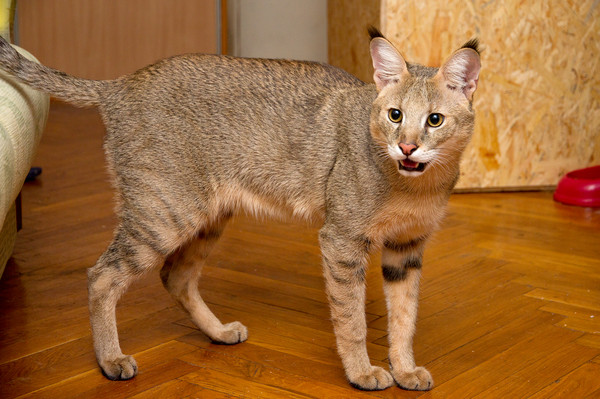The Chausie cat, named after the Latin word for Jungle Cat (Felis chaus), is a unique hybrid breed with a rich history and distinct characteristics. This guide delves into the breed’s history, physical traits, personality, health considerations, and care requirements, providing a detailed and SEO-friendly overview for cat enthusiasts and potential Chausie owners.
History and Origins
The Chausie cat’s lineage traces back to the ancient Egyptians who domesticated Jungle Cats for their amicable nature and hunting prowess. These cats were often mummified alongside their owners, signifying their esteemed status. The resemblance between the Jungle Cat and the Goddess Bastet, with her slender body and large ears, hints at the historical significance of this breed.
Occasionally, Jungle Cats mated with domestic cats, creating hybrids observed across regions from North America to Southeast Asia. However, the Chausie breed as we know it began in earnest in the 1990s. Breeders aimed to create a domesticated version of the Jungle Cat, leading to the Chausie’s official recognition by The International Cat Association (TICA) in 1995 and achieving Championship status in 2013.
Physical Characteristics
Chausie cats are renowned for their athletic build and striking appearance. They possess a tall, long-legged stature with a deep chest, enabling them to excel in running and jumping. Their large, upright ears, often tufted, and a sloping forehead and muzzle contribute to their wild yet elegant look. Chausie cats have flattened eyes on top with rounded bottoms, and exotically slanted cheekbones, giving them a distinctive appearance.
Chausies come in three main colors:
- Solid Black: These cats may have faint tabby markings as kittens but usually develop a dense black coat.
- Black Grizzled Tabby: Unique to the Chausie breed, this pattern involves black on black markings with alternating bands of off-white on individual hairs.
- Black Ticked Tabby: Featuring black ticking, stripes on the legs, black rings on the tail, and tabby markings around the eyes, these cats have a varying brownish background color.
Personality and Temperament
Chausie cats are highly athletic and active, maintaining a playful demeanor well into adulthood. Their sociable nature makes them affectionate companions who bond deeply with their owners. They are intelligent and require ample stimulation and interaction, thriving best in environments where they are not left alone for extended periods.
These cats are known for their loyalty and may struggle with rehoming as adults. They often get along well with other pets, including dogs, if introduced early. The breed’s high energy levels and curiosity make them suitable for active households where they can engage in play and exploration.
Health and Dietary Needs
Chausie cats may inherit a shorter intestinal tract from their Jungle Cat ancestors, making them more prone to food allergies and digestive issues. Breeders recommend feeding them high-quality commercial cat foods with minimal plant-derived ingredients. Some advocate for homemade raw or cooked meat diets, but these should be prepared under expert guidance to ensure nutritional adequacy and safety.
Regular veterinary check-ups are essential to monitor for potential health issues, including inflammatory bowel disease, which can arise from dietary sensitivities.
Care and Maintenance
Owning a Chausie cat requires commitment due to their high energy and social needs. Here are some care tips:
- Diet: Provide a balanced diet with high-quality protein sources. Avoid foods with high plant content to prevent digestive issues.
- Exercise: Engage your Chausie in regular play sessions. Toys, climbing structures, and interactive games are essential to keep them mentally and physically stimulated.
- Companionship: Ensure your Chausie has company, whether from other pets or family members. They do not do well in isolation.
- Grooming: Regular brushing helps manage their short coat and reduces shedding. Check their ears and teeth regularly to prevent infections.
Breeding and Genetic Diversity
Chausie cats are bred from a combination of Jungle Cats and domestic breeds such as Abyssinians and Oriental Shorthairs. This breeding practice aims to maintain their wild appearance while ensuring a domestic temperament. TICA’s breeding guidelines require that Chausie cats be several generations removed from their wild ancestors to qualify for competition.
The breed’s genetic diversity is enhanced by outcrossing to various domestic breeds, resulting in a robust and healthy population. Breeders focus on retaining the Chausie’s distinctive traits while improving their adaptability to domestic life.
Conclusion
The Chausie cat is a fascinating blend of wild elegance and domestic affection. Their unique history, striking appearance, and engaging personality make them a captivating choice for cat lovers seeking an active and intelligent companion. Proper care, diet, and social interaction are crucial to ensure a healthy and happy life for these exceptional felines. Whether you’re a seasoned cat owner or new to the world of hybrid breeds, the Chausie cat offers a remarkable and rewarding experience.

